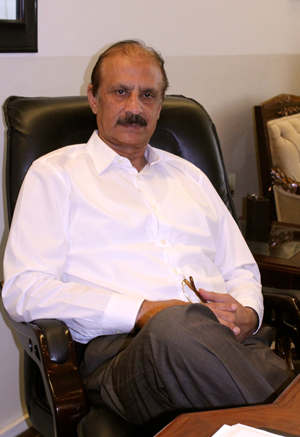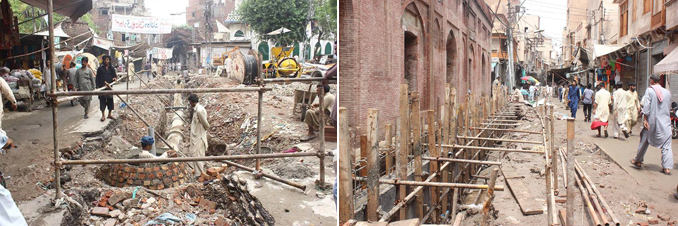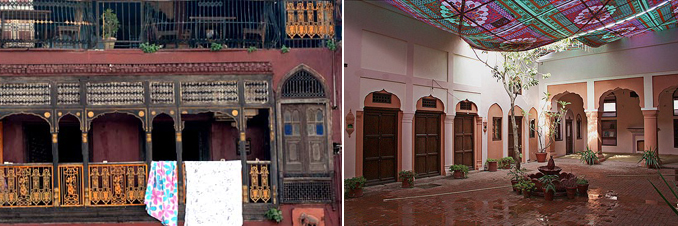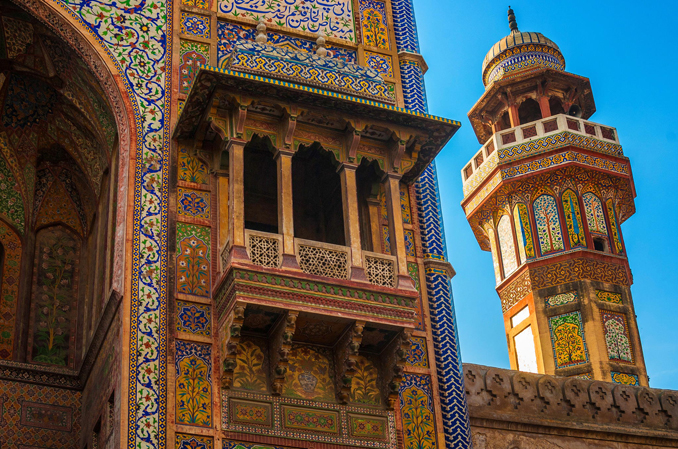
Written by: Salma Chaudhry and Aleeza Rasool
Posted on: September 02, 2014 |  | 中文
| 中文
Havelis in Delhi Gate (Image provided by WCLA)
For those well-acquainted with the Walled City of Lahore, it will be a surprise to witness the newly-illuminated Delhi Gate in its renewed splendor. Under the Royal Trail Project, 120 lights have been put up to illuminate this majestic entrance to the Androon Shehr (Inner City) of Lahore.
The towering walls and gates of Androon Shehr were built for the express purpose of defending the ancient city of Lahore against invading armies. With the British annexation of the Punjab in 1849, most of the 13 gates were destroyed and few remain today. Known for its consistently thronged narrow streets, excessive clatter and commotion and ancient buildings squeezed together alongside all manner of shops, the Inner City is undergoing an extensive renovation by the Walled City of Lahore Authority.
 |
Kamran Lashari (Photographer Aleeza Rasool) |
We had the pleasure of meeting the Director General of WCLA, Kamran Lashari, at his office on Lawrence Road, who elaborated for us the work of the Authority and its institutional framework.
“The main goal of this project is to conserve the customs and legacy of Androon Shehr along with ensuring sustainable development, essentially ensuring provision of modern living facilities to residents of the Walled City,” he explains. “This will automatically strengthen the economic potential of this area and promote tourism.”
Kamran Lashari took up the assignment of Sustainable Development at the Walled City of Lahore Authority with the Punjab Government, soon after retiring as Federal Secretary. “Sporadic interest had been shown in the Walled City by previous governments but was never really anything sustained or long term.” A dedicated, autonomous organization has come forward for the first time with the sole mandate of preserving the Walled City. “This is a big step forward; there aren’t many such organizations in other cities around the world.“
Mr. Lashari believes that creating an autonomous body for preservation is not enough, which is precisely why the WCLA also focuses on sustainability and public mobilization. The project’s main focus is on infrastructural development of the area. “People perceive it to be a decorative project which is not the case”, he clarifies. Thirty three streets of the Walled City have been dug up as part of the first phase of the restoration, which is almost 8 percent of the whole project. “Digging up each street 5 ft below the ground and laying pipes is not an easy task,” he elucidates further. But the greatest challenge that WCLA is facing is the mobilization of people. The project faces some resistance and it is difficult to convince people that this is being done for their own benefit and comfort.
 |
Underground sewage pipes and electricity cables being laid as part of the Sustainable Development of Walled City Project (Photographer Aleeza Rasool) |
There are almost 22,000 properties in the Walled City and the façade of the majority of those has been eroded. One of the major restoration works is being carried out at the Shahi Hamam in Delhi gate. Mr. Lashari hopes that the project would be complete by the end of this year and it will then be opened for tourists. WCLA has some support from the Norwegian Government and the Aga Khan Trust. “These are encouraging signs and we wish to have the corporate sector take interest in this as well.”
 |
Jharokas of Androon Shehr havelis (Image provided by WCLA) Mubarak Haveli (Photographer Aleeza Rasool) |
Mr. Lashari believes that real change can only come by changing people's mindsets. The work the WCLA is doing is not just about fixing brick and mortar, it is also about bringing order and raising some civic sense amongst the citizens. “Self involvement is deeply rooted in our society. An important aspect of our work involves gaining the residents’ trust by developing the necessary human connection.” The WCLA has a team of youngsters who go into the local communities to create awareness about the sustainable development of these areas. “Dealing with people requires patience; they will obviously resist because you’re entering their space and every inch of that space is close to their hearts. But the moment they understand the advantages they can accrue, they welcome you with open arms.” All the shopkeepers were compensated according to the market rate and it was only with their complete consent that the project began.
The WCLA has also initiated food festivals and cultural programs to promote the local cuisine, traditions and crafts of Androon Shehr. The team has been working hard to bring back to life the true Lahori spirit through various initiatives such as Kaun Bane Ga Khaba Ustaad 2014 and Master Chef Androon Lahore. The idea behind these two ventures was to bring all the greatest chefs from Androon Shehr to one place where people could come and enjoy their delicious fare. The event took place at the Food Street in Lahore and continued for 10 days. “We also organise art and crafts exhibitions, where numerous craftsmen from all over Lahore are invited to showcase their talents,” relates Mr. Lashari.
 |
Jharoka built on the front façade of Wazir Khan Mosque (Image provided by WCLA) |
Summing up the key objectives of the renovation project, Mr. Lashari explains that it endeavors to develop an institutional framework for Androon Shehr which includes enhancement of municipal atmosphere, conservation of traditions and customs, knowledge and increased awareness about sustainability and its usefulness, expansion of tourism to exploit the economic potential of the area and laying foundations for resourceful transfer linkages and human growth. “Community development and improvement in the living conditions of people is vital; tourism would just be a spillover of that.”
You may also like: